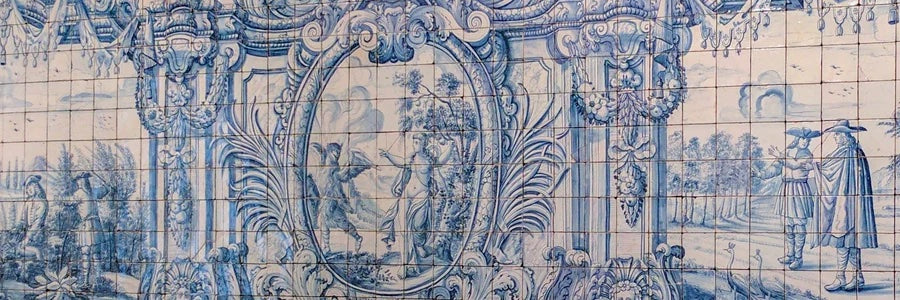Azulejos are painted ceramic tiles that hold great importance in Portuguese culture and architecture. They have been used for centuries to decorate buildings, churches, palaces, and homes, and today they are a key element of Portuguese cultural heritage.
The origins of Azulejo can be found in the tradition of Arab patterns, Italian tile craftsmanship, or Greek mosaic art. Beautiful tile paintings can also be found in other countries outside of Europe, such as the former Portuguese or Spanish colonies in America, Africa, and Asia. Masterpieces of tile painting can also be found in the Netherlands, Italy, and of course, the Middle East.
However, Portuguese artists have mastered this art and integrated it into everyday life in Portugal. This is why Azulejo has become a sort of trademark of Portugal today.
In Portugal, there are several types of Azulejos, each with its own style, meaning, and sometimes even its own manufacturing process.
Historical tiles
Azulejos are typically large tiles adorned with intricate and colorful designs that depict historical or mythological scenes. They were commonly used to embellish churches and royal palaces, and came to represent the grandeur and affluence of the Portuguese nobility.
These tiles often have a monochrome appearance, with shades of blue that only skilled painters and ceramists can produce.

Saint Laurent d'Almancil Church
They can also be very colorful, like the beautiful panels that cover the outside walls of the church of St. Lawrence of Almancil (Igreja Matriz de Santa Maria de Válega) which is located near Ovar south of Porto.

Igreja Matriz de Santa Maria, Valéga - Credit : Wikimédia
In Portugal, there are still craftsmen, sometimes grouped in small workshops, who are in charge of the restoration of old tiles and who agree to reproduce them identically.
The tiles are molded by hand and then painted by reproducing the ancient gestures studied during the restoration of historical azulejos. The mastery of the firing process allows to reveal all the shades of blue.

Hispano-Arabic tiles
Mudejar tiles, influenced by the forms and techniques developed by the Arabs, found in Portuguese buildings, are certainly examples commissioned by Portugal to Hispanic workshops, the largest manufacturing center for this type of tile being Seville.

The manufacturing method is inspired by the cloisonné technique of medieval enamels.
Watertight zones protected by separators are created to prevent the colors from mixing.

This particular technique, still applied by a few rare craftsmen allows to propose original objects such as coasters, coasters, paperweights or even pretty small boxes.

Figurative azulejos
Also called Azulejos "de figura avulsa" These azulejos depict animals, plants or scenes from everyday life. They were often used to decorate homes and public buildings and were very popular during the Renaissance.
These are Dutch-inspired tiles that appeared at the end of the 17th century, when patterned tiles went out of fashion. The designs range from castles, flowers and birds to people, boats and animals.

Geometric azulejos
These azulejos are characterized by geometric patterns, such as squares, triangles and circles, which create a repetitive and hypnotic pattern. They were used to decorate public buildings, such as train stations and museums, and were popular during the 1930s.

Padrão azulejos
These azulejos are intended to be assembled by 4 (2x2) and up to 144 copies (12x12) Their juxtaposition by group of 4 makes appear successively new motifs.
The motifs generally combine plants and geometric shapes, with a predominance of blue and yellow on white (at the beginning of the century) and polychrome total of blue, yellow, manganese and green (mid-century).

Floral azulejos
These azulejos depict flowers and plants, often in a naturalistic style. They were used to decorate gardens, fountains and public buildings, and are still very popular today.

Modern azulejos
These tiles were created in recent decades and are characterized by abstract patterns, bright colors and geometric shapes. They are often used to decorate public buildings and modern living spaces.
Charis Tsevis is a Greek visual designer who lives and works in Pafos, Cyprus. He produced a study on azulejos and modern mosaics in homage to Cristiano Ronaldo dos Santos Aveiro by mixing modern digital techniques and ancestral mosaic techniques.

Illustrations of mosaics based on traditional Portuguese painting (Azulejo). A tribute to Cristiano Ronaldo dos Santos Aveiro by Charis Tsevis
Tiles are an essential part of Portuguese culture and architecture. Each type of tile has its own meaning and style, reflecting the historical and cultural influences of the region.
Today, tiles are still used to decorate public buildings, churches and houses, and are considered an important part of the Portuguese cultural heritage.


2 comments
We recently bought some azujelos at a flea market in Alfama and couldn’t quite understand the history of them. They’re from a maker that did tiles in the 50’s-70’s and I was wondering if there’s a list of factories I could search or someone who could identify them by a picture.
I have a rare yellow, blue, and white tile, in a wooden frame!